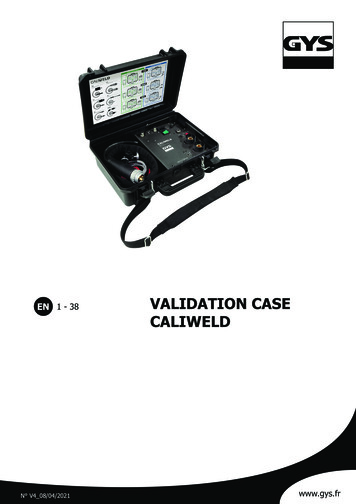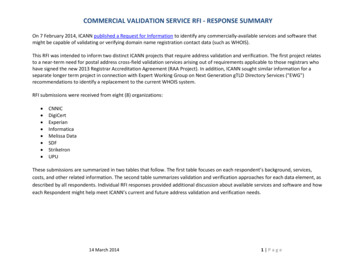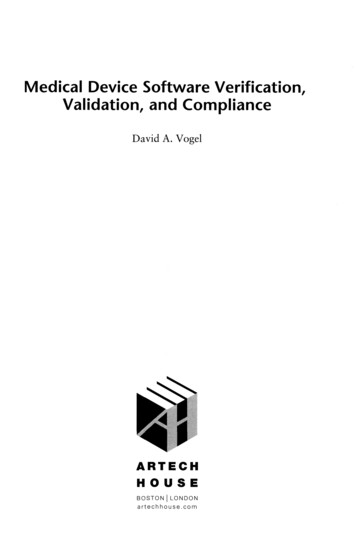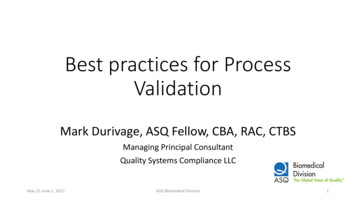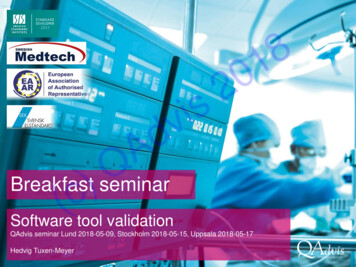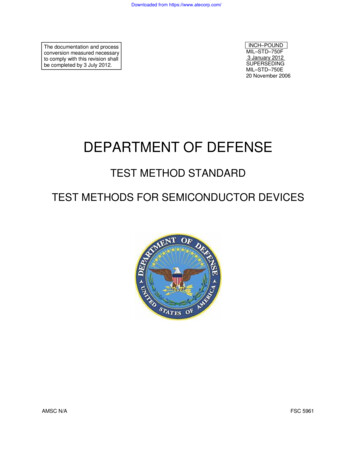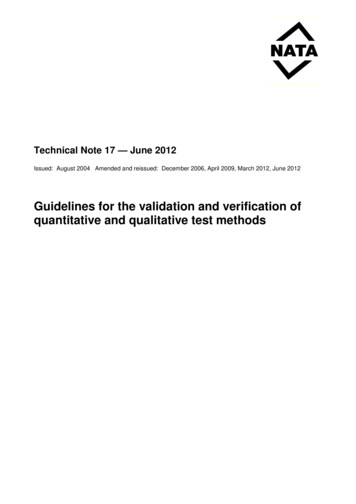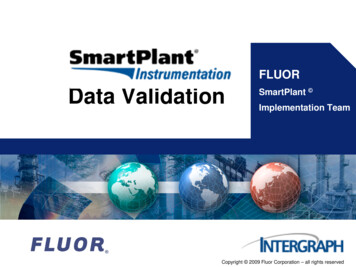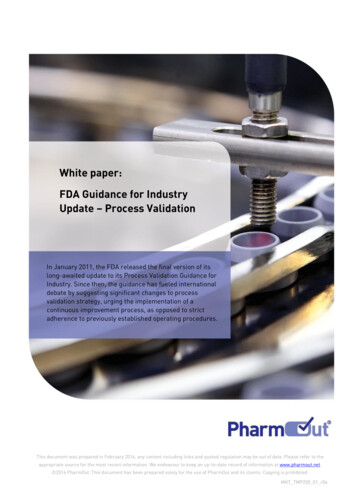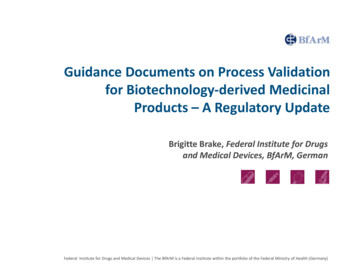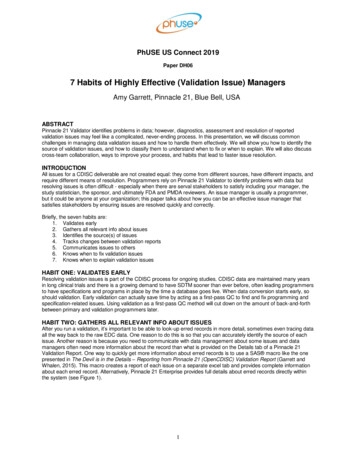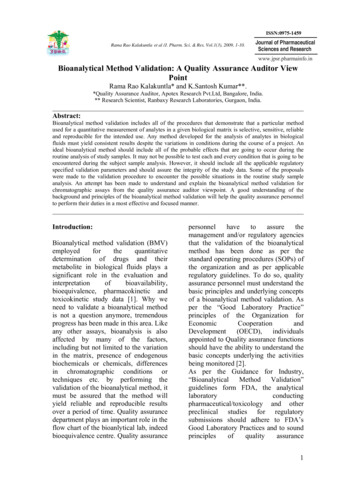
Transcription
ISSN:0975-1459Rama Rao Kalakuntla et al /J. Pharm. Sci. & Res. Vol.1(3), 2009, 1-10.Journal of PharmaceuticalSciences and Researchwww.jpsr.pharmainfo.inBioanalytical Method Validation: A Quality Assurance Auditor ViewPointRama Rao Kalakuntla* and K.Santosh Kumar**.*Quality Assurance Auditor, Apotex Research Pvt.Ltd, Bangalore, India.** Research Scientist, Ranbaxy Research Laboratories, Gurgaon, India.Abstract:Bioanalytical method validation includes all of the procedures that demonstrate that a particular methodused for a quantitative measurement of analytes in a given biological matrix is selective, sensitive, reliableand reproducible for the intended use. Any method developed for the analysis of analytes in biologicalfluids must yield consistent results despite the variations in conditions during the course of a project. Anideal bioanalytical method should include all of the probable effects that are going to occur during theroutine analysis of study samples. It may not be possible to test each and every condition that is going to beencountered during the subject sample analysis. However, it should include all the applicable regulatoryspecified validation parameters and should assure the integrity of the study data. Some of the proposalswere made to the validation procedure to encounter the possible situations in the routine study sampleanalysis. An attempt has been made to understand and explain the bioanalytical method validation forchromatographic assays from the quality assurance auditor viewpoint. A good understanding of thebackground and principles of the bioanalytical method validation will help the quality assurance personnelto perform their duties in a most effective and focused manner.Introduction:Bioanalytical method validation (BMV)employedforthequantitativedetermination of drugs and theirmetabolite in biological fluids plays asignificant role in the evaluation andinterpretationofbioavailability,bioequivalence, pharmacokinetic andtoxicokinetic study data [1]. Why weneed to validate a bioanalytical methodis not a question anymore, tremendousprogress has been made in this area. Likeany other assays, bioanalysis is alsoaffected by many of the factors,including but not limited to the variationin the matrix, presence of endogenousbiochemicals or chemicals, differencesin chromatographic conditions ortechniques etc. by performing thevalidation of the bioanalytical method, itmust be assured that the method willyield reliable and reproducible resultsover a period of time. Quality assurancedepartment plays an important role in theflow chart of the bioanlytical lab, indeedbioequivalence centre. Quality assurancepersonnelhavetoassurethemanagement and/or regulatory agenciesthat the validation of the bioanalyticalmethod has been done as per thestandard operating procedures (SOPs) ofthe organization and as per applicableregulatory guidelines. To do so, qualityassurance personnel must understand thebasic principles and underlying conceptsof a bioanalytical method validation. Asper the “Good Laboratory Practice”principles of the Organization ualsappointed to Quality assurance functionsshould have the ability to understand thebasic concepts underlying the activitiesbeing monitored [2].As per the Guidance for Industry,“Bioanalytical Method Validation”guidelines form FDA, the ology and otherpreclinical studies for regulatorysubmissions should adhere to FDA’sGood Laboratory Practices and to soundprinciplesofqualityassurance1
Rama Rao Kalakuntla et al /J. Pharm. Sci. & Res. Vol.1(3), 2009, 1-10.throughout the testing process [3]. In thisarticle, an attempt has been made tounderstand and explain the issues andconcepts of BMV.Chromatographic method like highperformance liquid chromatography(HPLC) and Gas Chromatography (GC)have been widely used for the bioanlysisof small molecules, with liquidchromatography coupled to triplequadrapolemassspectrometry(LC/MS/MS) being the single mostcommonly used technology.Essential parameters for validation of abioanalytical method include ty, reproducibility and Stability.The other important parameters includedilution integrity, matrix effect, andextraction efficiency. An attempt hasbeen made to explain the background ofeach of the validation parameter.LOQ at the RT of the analyte and IS.The acceptance criteria followed shouldbe as per the internal SOP. Forchromatographic assays, the peakresponse in blank matrix at the retentiontime of analyte should be not more than20% of the mean response of the LOQsamples and the peak response at the RTof the IS should be no more than 5% ofthe mean response of the IS of the LOQ.QA Auditor at this stage should ensurethat only blank matrix lots which wereshowed no significant interference willonly be used for further usage in thevalidation. An acceptance criteria shouldbe set in the SOP for the number ofbatches, like out of all screened lots, 80%( or any specification, which isacceptable as per applicable guidelines)should be acceptable. If the acceptancecriteria are not met then failure shouldbe investigated.Validation Parameters:2. Matrix Effect:1. Selectivity:The recent 3rd bionalytical workshopproposed determination of matrix factoras a way of assessing the matrix effect.Since ionization of analytes will beaffected by presence of endogenouscomponents in biological matrix, it couldbe either suppression or enhancement.Selectivity or specificity should beevaluated to assess the interference at theretention time (RT) of the analyte andinternalstandard(IS)withpredetermined method conditions. If thesingle method assesses one or more twoanalyte simultaneously, the interferenceshould be evaluated separately for eachanalyte individually. At least sox lots ofblank matrix are processed as per themethod, and after the run select the lot,which contain no or less interferenceamong the all lots and spike to preparethe limit of quantification (LOQ) as perthe method. Process six samples of LOQwith the addition of internal standard asper the method and inject. Then assessthe interference in all the lots of blankbatches against the mean response of theMatrix Factor (MF) can be calculated as,Matrix Factor (MF) Peak response in presence of matrix ionsPeak response in the abscence of matrix ionsWhere peak response could be peakarea, peak height, peak area ration orpeak height ratio according to themethod. Matrix Factor equal to 1indicates no matrix effect, matrix factorless than 1 indicates suppression andgreater than one indicates enhancement[4].2
Rama Rao Kalakuntla et al /J. Pharm. Sci. & Res. Vol.1(3), 2009, 1-10.The MFs can be determined for theanalyte and IS separately and a ratio of 2factors yields the IS normalized MF forthe analyte. Because of the similarities inchemical properties and elution times ofthe stable isotope labeled internalstandards relative to the analytes, theMFs for an analyte and its stable isotopelabeled IS are usually similar. The ISnormalized MFs using stable isotopelabeled IS are therefore usually close tounity for the bionalytical samples. Thaishas a very positive influence in reducingthe variability of the assay due to matrixeffects and makes the use of stableisotope labeled internal standards verydesirable in mass spectrometry(MS)based assays. It is recommended thatmatrix factor or IS normalized MF beingdetermined in six different lots ofmatrices. The variability in matrixfactors as measured by coefficient ofvariation (%CV) should be less than15% [4].3. Sensitivity:The lowest standard (LOQ) should beaccepted as the limit of quantification ofthe method. This test should beperformed to prove the reproducibilityfor samples at limit of quantificationlevel. Sensitivity should be evaluated byusing at least 5 replicates of the samplesat the limit of quantification. The sampleused for this evaluation should beindependent of calibration standards.The accepted limits for LOQ should be 20% for accuracy and 20% forprecision. In addition, signal to noiseratio(S/N) will also be calculated toevaluate the noise level. A minimumrecommended S/N ration could be 5:1,however acceptance criteria for thesignal to noise ratio depend on theindividual method.4. PreparationofCalibration/Quality control standards:Calibration standards can be defined as abiological matrix to which a knownamount of analyte has been added orspiked. Calibration standards are used toconstruct calibration curves, from whichthe concentrations of analytes in QCsand in unknown study samples aredetermined. In the same way, qualitycontrol standard (QC) is also a spikedsample used to monitor the performanceof a bionalytical method and to assessthe integrity and validity of the results ofthe unknown samples analyzed in anindividual batch [3]. Calibration/qualitycontrol standards preparation plays animportant role in the outcome of themethod performance. For the preparationof master stocks, an adequatelycharacterized standard reference materialmust be available, from which the otherdilutions may be prepared which will beused for the spiking of calibration/QCstandards [5]. Documentation of thecharacterization (certificate of analysis)must be available to the bionalyticallaboratory when this material is used formethod validation. Procedure defined inthe analytical method should befollowed for the preparation ofcalibration/QC standards. A QA Auditormust audit the process of preparation ofcalibration/QC standards for complianceand ensure that any special precautionsindicated in the certificate of analysisand/or analytical method is followedduring the process.5. Accuracy,Linearity:PrecisionandAccuracy and Precision should beassessed by analyzing at least 3validation batches including both intra3
Rama Rao Kalakuntla et al /J. Pharm. Sci. & Res. Vol.1(3), 2009, 1-10.and inter day runs. Both within andbetween run precision and accuracyshould be assessed. Each validationbatch must consist of at least 6 to 8 nonzero calibration standards, one standardblank (matrix blank) and standardzero(matrix blank with internal standard)and 6 replicates of quality controlstandards at each limit of quantification(LOQQC), low (LQC), middle (MQC)and high (HQC) levels. Limit ofquantification QC (LOQQC) should beprepared at the lower limit ofquantification of the method and lowlevel QC (LQC) should be prepared atabove the limit of quantification, but nomore than 3 times of the limit ofquantification. Middle level QC (MQC)should be prepared at the middle of thecalibration curve range; ideally, it shouldbe at the geometric mean of the low andhigh QC concentrations. The high QClevel (HQC) concentration should benear the upper calibration curve range.Ideally, it should be at around the 70 to80% of the highest calibration curvestandard, care should be taken that QCconcentration at low, middle and highlevels should not represent any of thecalibration curve standards.After the analysis of validation batches,regression model should be determinedby applying the simplest model thatadequately describes the concentrationresponse relationship using appropriateweighting and statistical tests forgoodness of fit. After confirming rddeviation,precision and accuracy at each LOQQC,LQC, MQC and HQC concentrationlevel. The acceptance criteria for theaccuracy and precision should bedefined in the SOP. The normalacceptance criteria will be, the betweenand with in batch CV for low, middleand high QC levels should be 15% andfor the LOQQC level should be 20%and the between and with in batch meanconcentrations should be with in 15%of the nominal values at low, middle andhigh QC concentration and should notdeviate by more than 20% at theLOQQC concentration.6. RecoveryEfficiency:orExtractionRecovery can be determined bycomparing the detector response of theanalyte or IS from an extracted sampleto the detector response of the analytefrom an unextracted sample representingthe 100% recovery. Analytical methoddetermines the type of unextractedsample to be used. Unextracted samplecould be a neat drug solution or theblank plasma sample processed andreconstituted with the neat drug solutionto represent the 100% recovery.Recovery will be evaluated at low,middle and high QC concentrations, theaverage recovery of the analyte or IS atthree levels could be considered as therecovery. At least 6 samples at each QClevel should be injected. Recovery doesnot need to be very high, but must beconsistent, precise and reproducible.However, if the reported recovery ismore than 100%, justification forreporting the same need to be mentionedin the validation report. Acceptancecriteria for recovery evaluation could bestated in the SOP. Recovery deemedacceptable if %CV is, 15% for %meanrecovery between low, middle and highQC levels.7. Dilution Integrity:Dilution of the study samples will beperformedwhentheobtained4
Rama Rao Kalakuntla et al /J. Pharm. Sci. & Res. Vol.1(3), 2009, 1-10.concentration is exceeding the upperlimit of quantification or when there isless sample availability compared to themethod requirement. Dilution integritycan be tested for nay dilution rangingfrom 1:2 to 1:10; preferably, dilutionintegrity will be evaluated at 1:2 and 1:4.adilutionintegritystandard(approximately at a concentration of twotimes the concentration of 90% ULOQ)will be prepared and frozen for a periodof at least 24 hours, on the day ofevaluation, the dilution integritystandard could be diluted for 6 replicateseach by a factor of 2 times and 4 timesusing the prescreened blank plasma.Dilution integrity samples will beprocessed and analyzed against a freshlyprepared calibration curve. Acceptancecriteria could be the precision andaccuracy of the dilution integrity QCs is 15% and with in 15% of the nominalconcentrations respectively.8. Carry Over:Carry over test will be performed toobserve any carry over form theinstrument from one sample to the nextsample. To evaluate carry over a blanksample will be placed next to the ULQstandard in the sequence. Calculate theabsolute peak response as percentage ofthe LOQ standard. Carry over should beconsidered not significant when theresponse in the blank sample is 20% ofthe LOQ sample.9. Anticoagulant Effect:Anticoagulant effect will be evaluated ifthe anticoagulant is different in theplasma used for the preparation of CC,QC samples and study samples. 6replicates of low and high QC sampleswill be spiked with the matrix used inthe method validation and another 6replicates of low and high QC sampleswill be spiked with the matrix that shallbe used in the study samples. Calibrationstandards will be prepared with thematrix used in the method validation andprocess and analyze all the samplestogether as per the method. The effect ofanticoagulant is deemed nullified of theprecision and accuracy of the QC’s is 15% and with in 15% of the nominalconcentrations respectively.10. Stability Evaluations:Drug stability is a function of thechemical properties of the analyte, thestorage conditions, the matrix/solutionsin which it is stored, and the containersystem. The stability tests should reflectthe situations likely to be encounteredduring actual subject sample handlingand analysis. The stability of analyte inthe matrix during collection and storageof samples should be assessed. Thedifferent stability evaluations need to beperformed, but not limited to be:(a) Short-term stability of analyte(s)and internal standard(s) insolution/solvent.(b) Long-term stability of analyte(s)and internal standard(s) insolution/solvent.(c) Stability of analyte followingsampleprocessing(postpreparative stability)(d) Freeze and Thaw stability.(e) Short term stability of analyte inmatrixatroomtemperature(bench top stability)(f) Long-term stability of analyte inspiked samples and incurredsamples.5
Rama Rao Kalakuntla et al /J. Pharm. Sci. & Res. Vol.1(3), 2009, 1-10.Solutions/samples may be stored at lessstressful conditions than the provenstability conditions at which they weretested. For example, if stability is provenat -20C then the stability at -70C isautomatically defined; based on theArrhenius principle of chemicalreactivity, lower rates of reactivity(analytedegradation)atlowertemperature. However, the counterargument to the above inference shouldalso be considered valid, since lowertemperature may cause denaturation ofthe matrix proteins, which may affect theprotein binding and ability to extractdrug from the matrix, here the matrixdegradation and not the chemicalstability was the issue. Decision basedon the above counter arguments shouldbe considered from case to case basis.(a) Analyte and IS stock solutionstability in solvent/solution:Prepare analyte, IS master stocksolutions, and keep aliquots of the sameat refrigerated temperature or as requiredby the specific method. These samplesserve as stability stock solutions.Following the required period ofstability, prepare fresh stock solutions ofthe analyte and IS, these solutions serveas comparison stock solutions. Whenperforming the stability evaluation forthe first time, on the day of evaluationremove the stability stock solutions andkeep on workbench for a period of atleast 4 to 6 hours. After the completionof anticipated time, prepare appropriateequivalent dilutions from both stabilityand comparison stock solutions. Inject 6replicates of the stability and comparisonstock dilutions, and calculate the mean,S.D and %CV of the peak area responseof each of the above stability andcomparison stock solutions. % stabilityshall be calculated as follows:% Stability Mean response of stability samples 100Mean response of comparision samplesThe stability is deemed acceptable if %stability is with in the range of 85-115%.Appropriate correction factor needs to beapplied to peak area response ofcomparison samples to account fordifference in the stock weights. Stabilityexercise needs to be performed at regularintervals to cover anticipated storageperiod of the stock solutions in theintended study. Keeping the stocksolutions on the workbench is requiredonly for the first time evaluation of thestability period; it may not be requiredfor the extended stability evaluations ofthe same stock solutions. If theacceptance criteria are not met for aparticular stability period, then stabilityevaluation for a shorter period will beperformed.(b) Stability ofdilutions:analyteandISStability of dilutions containing analyte(analyte spiking solution), IS (IS spikingsolution) and a solution containing boththe analyte and IS needs to be evaluatedat the specified storage conditionsdepending on the individual method. Thedilutions are prepared from the masterstock (stability dilutions) are kept at thespecified storage conditions 9normallyrefrigerated conditions) for a period oftime as required. On the day ofevaluation, fresh dilutions are preparedfrom the same master stock, which wasusedascomparisondilutions.Appropriate intermediate dilutions areprepared from both stability as well as6
Rama Rao Kalakuntla et al /J. Pharm. Sci. & Res. Vol.1(3), 2009, 1-10.comparison dilutions and 6 replicates areinjected. Mean, S.D. and %CV and%stability are calculated and theacceptance criteria of stock solutionstability is applicable to this one.Demonstrating the stability of thedilutions of the analyte, IS and a solutioncontaining both the analyte and IS offersthe flexibility to use the solutions for alonger period, rather than preparing themevery day.Matrix Stability:(c) Stability of analyte followingsampleprocessing(Postpreparative or auto samplerstability):Post preparative stability is evaluated tocover the anticipated run time for theanalytical batch, and to handle thesituations like system malfunctioningetc. where samples are injected after acertain period of time. Process 6replicates of QC samples at low and highconcentrations and place the samples inthe auto sampler as per the specificationsof the analytical method. After thestability period, the same QC samples(test samples) will be injected along withthe calibration standards and another setof freshly extracted QC samples(reference samples). All the QC sampleconcentrations are back calculated usingthe calibration curve.(d) Short term stability of analyte inmatrix at room temperature(Bench Top Stability):Bench top stability evaluation will beperformed to evaluate the stability of thesamples, which were kept on benchduring the extraction process. Theanticipated time for the bench topstability (usually 4 to 24 hours) shouldcover the duration of the time, it takeswhile extraction process. 6 replicates ofQC samples at low and high levels willbe removed from the freezer on theafternoon prior to the day of evaluationand left to remain on the bench top untilthe following day. On the day ofevaluation, bench top stability samples(test samples) along with the calibrationcurve and 6 sets of freshly spiked QCstandards at low and high levels(reference samples) will be processedand injected.(e) Freeze-Thaw Stability:Freeze-Thaw stability evaluation will beperformed to evaluate the stability of theanalyte in the matrix after multiplecycles of freezing and thawing.Generally, freeze thaw stability will beperformed for three cycles, the numberof cycles will be increase or decreased asper the requirement keeping in the mindthe stability of the drug tested. 6 sets oflow and high level QC samples (testsamples) prepared during the bulkspiking should be stored in the freezerfor at least 24 hours, after that the samesamples are withdrawn from the freezerand allow them to thaw unassisted atroom temperature and then refreeze thesamples for a minimum of 12 hours.Repeat the same exercise for two moretimes. While thawing at each cycle, thetest QC samples should be uncapped tomimic the situation encountered for thestudy samples. After the requirednumber of cycles, on the day ofevaluation, remove the freeze-thawedtest QC samples along with thecalibration curve and 6 sets of freshlyspiked QC standards at low and highlevels (reference samples) and processall the samples and analyze.7
Rama Rao Kalakuntla et al /J. Pharm. Sci. & Res. Vol.1(3), 2009, 1-10.(f) Long term Stability:Long-term stability evaluations will beperformed to demonstrate the stability ofthe analyte in the matrix for longerduration of time. The anticipatedduration for the long terms stabilityshould cover the duration of time formthe first sample collection to the lastsample analysis of the study. Long-termstability evaluation should be performedon at least three separate occasions tocover the entire stability period.Following the appropriate stabilityperiod, 6 sets of low and highconcentration QC samples (test samples)will be removed from the freezer andprocessed along with the calibrationcurve and 6 sets of freshly spiked lowand high concentration QCs (referencesamples) and analyze.The acceptance criteria for the postpreparative stability (auto samplerstability) bench top stability, freeze thawstability and long-term stability shouldbe, the relative means of back calculatedconcentrations (test/reference) for bothlevels tested must be with in 85-115%.An additional check point may added tothe acceptance criteria, that 4 out of 6QCs of both test and reference samplesmust be quantifiable and with inspecifications. This additional checkpoint is needed, since in some of thecases, both test and reference QCconcentrations may be out of thespecification of 85-115% of the nominalfor accuracy (for example both test andreference QCs failing on either lowerside or higher side), even though as weare measuring the test/ reference ratio,the final outcome may give theconclusion as the evaluations is meetingthe specifications. To overcome suchtype of false interpretations a mechanismshould be in place in the SOP to addresssuch situations.Combined evaluation of freeze thaw,bench to and long-term stability:During the validation, freeze thawstability, bench top stability and longterm stability evaluations are performedseparately to assess the stability for theintended stress conditions. However, thestudy samples (unknown samples) mayundergo the combined effect of all theabove-mentioned stress conditions.Therefore, it is advisable to evaluate theso-called combined affect of differentstress conditions during the validationphase.The combined stress conditions effectmay be evaluated in the followingmanner. Prepare 6 sets of QC samples(low and high levels) and stress forrequired number of freeze thaw cyclesand store for the anticipated long termstorage period. After the anticipatedlong-term storage of the freeze thawedsamples, stress the same samples forbench top conditions. Then process andanalyze the same QC samples along withthe calibration curve and 6 sets offreshly spiked QC samples at low andhigh levels (reference samples). Theacceptance criteria may set as like anyother individual stability evaluations.Extended Precision and Accuracy:Extended precision and accuracy will beevaluated to decide how much maximumnumber of samples can be analyzed in assingle batch of analytical run. Most ofthe validation batches were small, whereas during the routine subject sampleanalysis; we may process and analyzethe samples of tone or more subjects at a8
Rama Rao Kalakuntla et al /J. Pharm. Sci. & Res. Vol.1(3), 2009, 1-10.time. This evaluation will helps ingetting the preliminary idea of as howmany samples can be analyzed in asingle batch. For this evaluation, processand analyze at least 30 to 35 sets of low,middle and high QC samples against asingle calibration curve. The exactnumber of QC samples will be decidedby keeping in mind the expected size ofthe analytical batch in the study. Extraextended precision and accuracy batchmay not be required if one of the batchanalyzed during the validation containsthe number of anticipated samples in thestudy. The acceptance criteria for theextended precision and accuracy batchshould be the mean back calculatedconcentration values for the low, middleand high QC concentrations should bewith in 15% of their nominalconcentrations and the CVs for low,middle and high QC concentrationsshould be 15%.Evaluation of prepared samplereinjection/reanalysis capability:Prepared samples may be reinjected orreanalyzed when the run sequence wasinterrupted in between the sequence dueto any of the reasons like instrumentmalfunction, fluctuation in the powersupply etc. In these cases, some of thesamples are injected and some are notinjected. After certain period, when theinstrument and other conditions areready, there may be a situation, whetherto continue the sequence from where therun ahs stopped or to reanalyze thewhole sequence from the startingincluding the calibration curve. To take aconfidant decision in these type ofsituations, which may occur during thesubject sample analysis, a simplevalidation exercise could be performed.Process a set of calibration standards and6 QC sets of low and high levelconcentrations (test stability samples)and analyze and determine whether thecalibration/QC standards are with in thespecifications. If the samples are with inthe specifications, keep the samples inthe auto sampler for the required periodof time (usually 24 to 48 hours). Thenafter the completion of the intendedduration inject the whole sequence forthe second time. Check for thespecifications of the reinjected run. If thereinjected samples are with in thespecifications, then it may be concludedthat the samples has the reinjectionstability. Then quantify the reanalyzedtest stability samples with the firstinjected calibration curve, if the teststability samples are with in thespecifications with the first injectedcalibration curve also, then it may beconcluded that the interrupted sequencemay be started from where it wasinterrupted. If the test stability samplesare not meeting the specifications whenquantified against the first injectedcalibration curve, it may be concludedthat, whenever the re is an interruptionof the run sequence, the whole sequenceincluding the calibration curve must bereinjected.Conclusion:An attempt has been made to understandand explain the bioanalytical methodvalidation from a quality assuranceauditor viewpoint. Some of the proposalswere described for inclusion in thevalidation parameters for the differentsituations encountered in the studysample analysis.9
Rama Rao Kalakuntla et al /J. Pharm. Sci. & Res. Vol.1(3), 2009, 1-10.References:[1][2][3][4][5]Vinod P Shah. The history ofbioanalytical method validation andregulation: Evolution of a guidancedocument on bioanalytical methodsvalidation. The AAPS Journal 2007;9(1) Article 5.Organization for economic co-operationand development. OECD series onprinciples of Good Laboratory Practiceand compliance monitoring number 4(revised). GLP consensus document:QualityAssuranceandGLPenvironment directorate. Organizationforeconomicco-operationanddevelopment, Paris 1999.Food and Drug Administration.Guidance for industry; BionalyticalMethod Validation, Center for DrugEvaluation and Research, May ofbioanalytical method validation forsmall molecules. The AAPS Journal2007; 9(1) Article 11.William Nowatzke and Eric Woolf.Best practices during bionalyticalmethodvalidationforthecharacterization of assay reagents andthe evaluation of analyte stability inassay standards, quality controls andstudy samples. The AAPS Journal2007; 9(2) Article 13.10
analyte individually. At least sox lots of blank matrix are processed as per the method, and after the run select the lot, which contain no or less interference among the all lots and spike to prepare the limit of quantification (LOQ) as per the method. Process six samples of LOQ with the addition of internal standard as per the method and inject.
